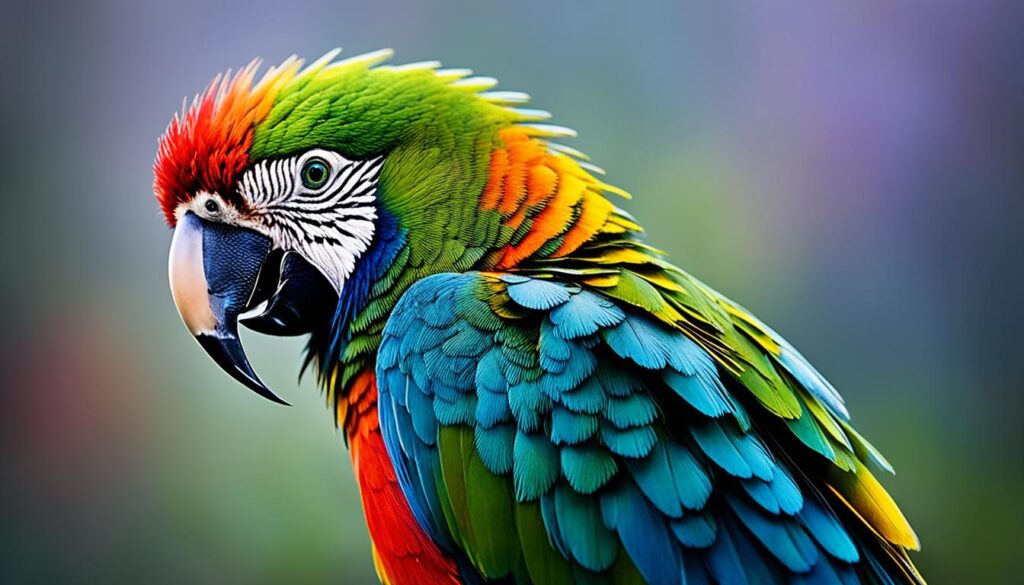Did you know that there are over 1,115 colors described for birds in Robert Ridgway’s “Color Standards and Color Nomenclature”? This astounding fact underscores the incredible diversity and vibrancy of the avian realm. From the striking scarlet of a cardinal to the brilliant blue of a jay, the feathered denizens of our planet display an unparalleled array of hues that captivate and enchant us.
In this comprehensive guide, we will embark on a captivating journey through the vibrant and diverse world of bird colors. Delving into the science behind feather pigmentation, we will unravel the mysteries of how these winged wonders acquire their stunning plumage. Moreover, we will explore the significance of bird color patterns, examining their role in camouflage, mating displays, and other essential behaviors.
Whether you’re an avid bird watcher, a nature enthusiast, or simply someone fascinated by the natural world, this article will provide you with a deeper appreciation for the colorful wonders of the avian realm. So, let’s dive in and discover the captivating diversity of what color are birds, bird color, avian coloration, and more!
Key Takeaways
- The avian world is home to over 1,115 distinct colors, showcasing the incredible diversity of bird plumage.
- Bird color patterns play a crucial role in camouflage, mating displays, and other essential behaviors.
- Understanding avian coloration provides valuable insights into the evolution and adaptations of different bird species.
- Exploring the vibrant hues of birds can foster a deeper appreciation for the natural world and inspire conservation efforts.
- Factors like habitat, diet, and species diversity influence the prevalence of colorful birds in different regions.
Introduction to the Vibrant Avian Realm
The natural world is teeming with an incredible diversity of avian species, each adorned with a unique palette of what color are birds. From the brilliant reds and oranges of tropical parrots to the serene blues and greens of temperate songbirds, the bird color spectrum is a true feast for the eyes. Exploring the avian coloration of these feathered marvels not only captivates our senses but also unveils the profound significance these feather pigmentations and plumage shades hold in the lives of avian hues.
The Mesmerizing Diversity of Bird Colors
The sheer what color are birds that adorn the avian world is a testament to the remarkable evolutionary adaptations that have taken place over millions of years. Each species has developed its own unique bird color patterns, from the iridescent hues of hummingbirds to the bold stripes of woodpeckers. This avian coloration not only captivates our senses but also serves essential functions in the lives of these feathered creatures.
Why Understanding Bird Coloration Matters
Delving into the complexities of feather pigmentations and plumage shades is more than just a visual delight; it offers invaluable insights into the survival, communication, and reproductive strategies of avian hues. By understanding the role that what color are birds play in the lives of these remarkable creatures, we can gain a deeper appreciation for the intricate web of life that connects all living beings on our planet.
“The colors of birds are among the most brilliant and beautiful in all of nature. They are the result of millions of years of evolution, serving essential functions in the lives of these remarkable creatures.”
Feather Pigmentation: The Source of Avian Hues
The vibrant colors of birds are primarily derived from the pigments present in their feathers. These pigments, such as carotenoids and melanins, are responsible for creating a vast array of plumage shades and avian hues. The distribution and concentration of these pigments within the feather structure determine the specific color patterns observed in different bird species.
More than 10,000 bird species worldwide exhibit a diverse range of colored feathers. Pigments in bird feathers come from three main groups: carotenoids, melanins, and porphyrins. Carotenoids, which are obtained from plants, contribute to bright yellows in birds like goldfinches, Yellow Warblers, and Blackburnian Warblers. Melanin, found as granules in bird feathers, can produce colors ranging from black to reddish browns and pale yellows.
Feather coloration containing porphyrins fluoresces a bright red under ultraviolet light and is present in some owl, pigeon, and turaco species. Birds with unusual levels of pigments can exhibit dramatic color abnormalities, observed in species like Canada Goose, American Crow, and House Sparrow.
The diversity of avian hues also comes from structural colors produced by the refraction of light by proteins in feathers. Examples of structural colors include iridescent colors seen in hummingbirds and non-iridescent colors produced by scattered light in feathers with air pockets. Blue feathers in birds like Indigo Buntings, Mountain Bluebirds, and Blue Jays are typically a result of structural colors.
“Birds are considered the most colorful terrestrial vertebrates, along with insects and coral reef fishes.”
Many bird species’ feather structures reflect light in the ultraviolet range, giving them the ability to perceive a wider range of colors than humans. The most spectacular feather pigmentation in birds typically serves to impress members of the same species.
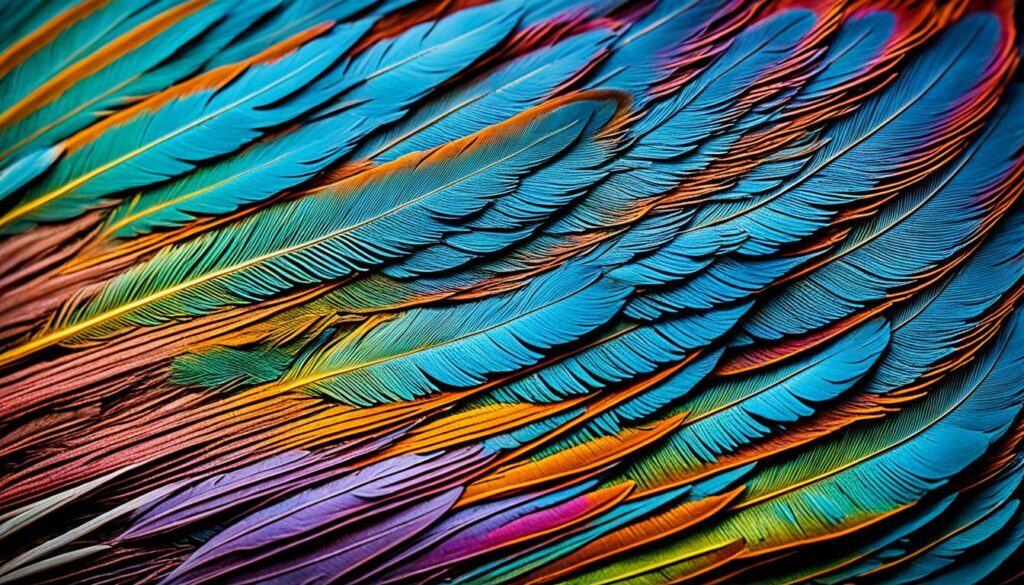
Bird Color Patterns and Their Significance
The diverse color patterns found in birds serve essential functions, from camouflage and survival to courtship and mating. Understanding the significance of these vibrant hues provides valuable insights into the intricate world of avian biology.
Camouflage and Survival Tactics
Cryptic coloration helps many species blend seamlessly into their surrounding environment, providing protection from predators and aiding in their hunting and foraging strategies. For instance, the Pileated Woodpecker’s predominantly black and white color pattern allows it to camouflage within the bark of trees, while the Yellow-headed Blackbird’s black body and bright yellow head help it conceal itself in the lush foliage.
Mating and Courtship Displays
On the other hand, bold and vibrant plumage is often used in elaborate mating displays, where males showcase their colorful feathers to attract potential mates. The male American Redstart’s jet black head and body, accented with orange patches, serve as a stunning visual display during courtship. Similarly, the Lazuli Bunting’s blue upper body and orange breast make it a true avian beauty, captivating potential partners.
From the Nashville Warbler’s distinctive white eye-ring to the Blue-headed Vireo’s bold spectacles, the diverse color patterns of birds play a crucial role in their survival and reproductive success. By understanding these remarkable adaptations, we can gain a deeper appreciation for the intricate beauty and complexity of the avian world.
“Plumage patterns contribute to birds’ adaptation to different habitats and environments, enhancing our understanding and appreciation of avian diversity.”
Exploring the Rainbow: Common Colored Bird Species
The avian world is a true marvel, boasting a stunning array of colorful species that captivate birdwatchers and nature enthusiasts alike. From the vibrant reds of cardinals and tanagers to the brilliant blues of bluebirds and jays, these feathered wonders offer a feast for the eyes.
Vibrant Reds: Cardinals and Tanagers
The cardinal is a beloved backyard visitor, known for its bright red plumage and distinctive crest. These charismatic birds are a common sight across the eastern and central United States, where their cheerful songs and bold appearance make them a favorite among bird lovers. Another striking red bird is the tanager, a migratory species that showcases a stunning array of reds, oranges, and yellows during the breeding season.
Brilliant Blues: Bluebirds and Jays
The striking blue hues of bluebirds and jays are a true delight to observe. Bluebirds, with their vibrant cerulean plumage, are a common sight in open habitats and rural areas, while jays, known for their bold coloration and distinctive calls, are frequent visitors to backyard feeders and wooded areas.
These common colored bird species are just a glimpse into the incredible diversity of avian coloration found in the natural world. From the fiery reds of cardinals to the captivating blues of bluebirds and jays, these feathered wonders are a testament to the beauty and complexity of the avian realm.
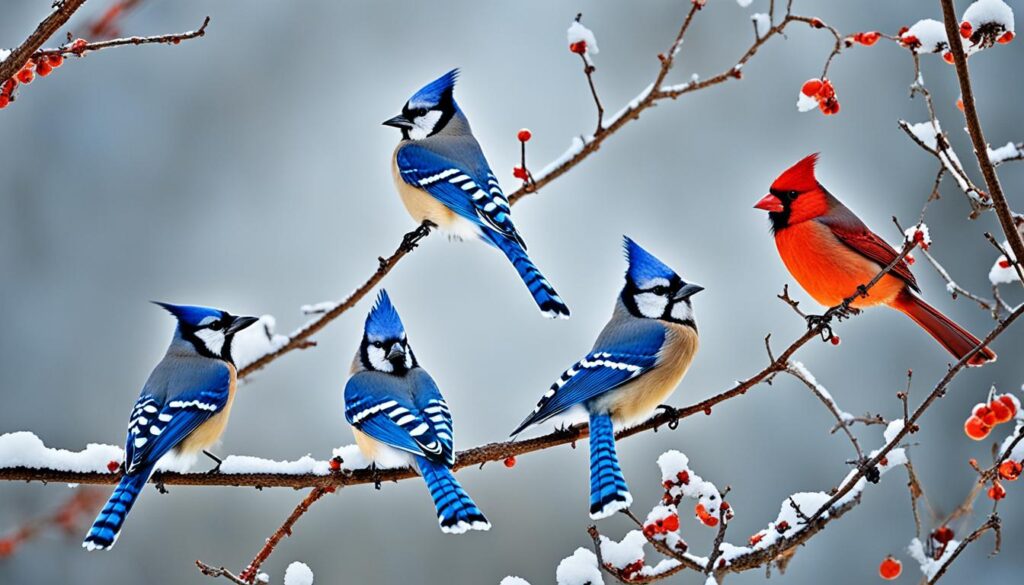
“The colors of birds are among the most brilliant in nature. They rival the colors of flowers, precious gems, and sunsets.” – Birdwatching Magazine
Avian Coloration in Different Habitats
The captivating colors of birds are not merely aesthetically pleasing, but also a reflection of their remarkable adaptations to the environments they inhabit. From the dazzling jewel-toned plumage of tropical birds to the muted hues of their Arctic and Antarctic counterparts, avian coloration varies dramatically across different habitats.
Tropical Paradises and Their Feathered Jewels
In the lush, vibrant tropics, birds often display a breathtaking array of colors that resemble precious gemstones adorning the verdant foliage. Brighter feathers in tropical birds serve to showcase their strength, health, and alertness to potential mates and rivals. These bold hues can also function as a warning to predators or attract desirable partners, demonstrating the individual’s good genes and maturity.
According to a study analyzing over 24,000 images of 4,500 birds worldwide, tropical birds are on average 30% more colorful than their temperate counterparts. This trend is particularly pronounced in countries like Brazil, New Zealand, Indonesia, Australia, Ecuador, and Chile, where the avian inhabitants boast a remarkable spectrum of colors.
Arctic and Antarctic Avian Adaptations
In stark contrast, birds inhabiting the harsh environments of the Arctic and Antarctic regions have evolved specialized adaptations, including muted coloration that helps them blend seamlessly with their surroundings. The need for camouflage and thermal regulation in these extreme climates has led to the development of more subdued hues, often in shades of white, gray, and brown.
Interestingly, the color patterns of birds can also play a significant role in their identification and the differentiation between male and female individuals, particularly during the breeding season. Many species exhibit sexual dimorphism, where the males display brighter, more vibrant plumage to attract mates, while the females typically have duller, more camouflaged coloration.
“Brighter colors in birds help show off strength, health, and alertness to potential mates and intruders.”
The remarkable diversity of avian coloration highlights the remarkable ways in which birds have adapted their appearance to thrive in the unique environments they inhabit, from the lush tropics to the vast, frozen expanses of the polar regions.
what color are birds: Unraveling the Mystery
The diverse array of colors found in the avian world can be truly captivating, leaving many people wondering: “What color are birds?” This section will delve into the mystery behind the incredible range of hues that birds exhibit, shedding light on the intricate mechanisms that govern their coloration. Readers will gain a deeper understanding of the factors that contribute to the vibrant and varying colors of our feathered friends.
From the brilliant red of a cardinal to the stunning blue of a bluebird, the what color are birds in the natural world are a sight to behold. Bird color and avian coloration are the result of a complex interplay between pigmentation, feather structure, and environmental factors. By exploring the secrets of this colorful avian realm, we can uncover the true nature of the diverse hues that adorn our feathered companions.
“The colors of birds are among the most brilliant and beautiful in all of nature.”
One of the key factors contributing to the what color are birds is the presence of pigments in their feathers. Carotenoids, for instance, are responsible for the vibrant orange shades seen in species like the Baltimore Oriole and American Redstart. These pigments are obtained through the bird’s diet and play a crucial role in signaling health and fitness to potential mates.
But the story of bird color doesn’t end there. Melanin pigments, such as eumelanin and pheomelanin, also contribute to the avian coloration, producing a range of hues from black and brown to reddish-brown. The relative abundance of these pigments determines the specific color patterns observed in different bird species.
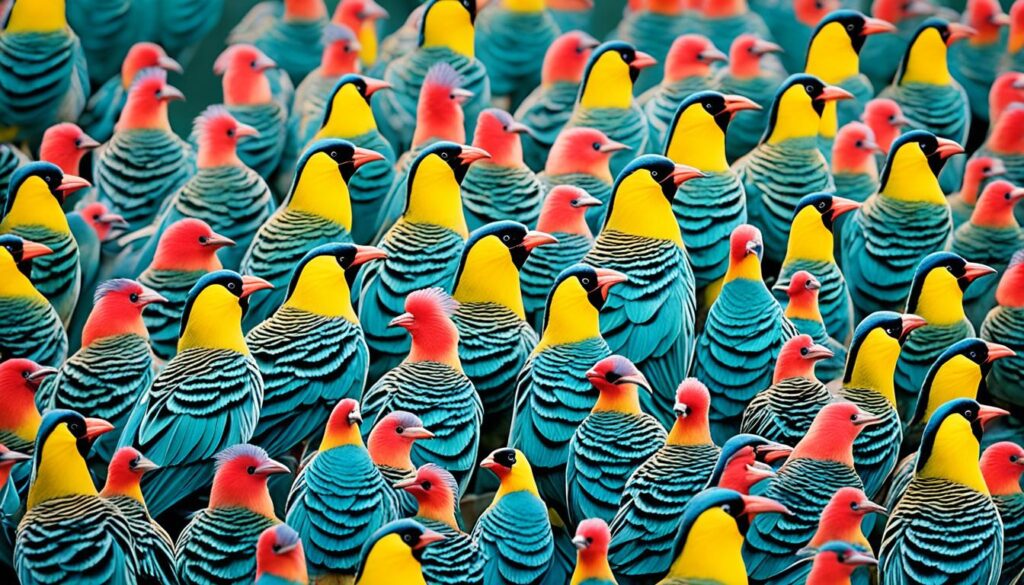
Beyond pigmentation, the microscopic structure of feathers plays a crucial role in creating the stunning visual displays of what color are birds. The intricate arrangement of barbs and barbules, which interlock to form the feather’s vane, can produce iridescent and structural colors that shimmer and change as the bird moves.
As we continue to unravel the mystery of bird color and avian coloration, we gain a deeper appreciation for the remarkable diversity and adaptations of our feathered friends. From the vibrant plumage of tropical species to the camouflaged hues of Arctic and Antarctic birds, the world of what color are birds is a true marvel of nature.
The Role of Diet in Bird Feather Colors
When it comes to the vibrant and diverse feather colors of birds, their diet plays a crucial role. The rich hues that adorn the plumage of our feathered friends are not solely determined by their genetics – environmental factors, particularly the diet, have a significant influence on the development of these captivating feather colors.
At the heart of this connection are carotenoids, a group of pigments that birds obtain from the foods they consume. These vibrant pigments are then deposited in the birds’ feathers, contributing to their overall plumage coloration. The types and concentrations of carotenoids in a bird’s diet directly impact the intensity and variety of feather colors they display.
For instance, birds that feed on berries, fruits, and other carotenoid-rich foods tend to exhibit more vivid reds, oranges, and yellows in their feathers. Conversely, birds with diets lacking in these essential pigments may showcase more muted or dull feather colors.
“The colors of a bird’s feathers are not just a result of its genetics, but also a reflection of the nutrients it acquires through its diet.”
Understanding the role of diet in shaping the vibrant feather colors of birds is crucial for researchers, birdwatchers, and conservationists alike. By studying the dietary preferences and carotenoid intake of different bird species, we can gain valuable insights into the factors that contribute to the remarkable diversity of avian plumage.
In the ever-evolving and captivating world of birds, the diet remains a crucial piece of the puzzle in unlocking the secrets behind their vibrant feather colors. By exploring this fascinating connection, we can gain a deeper appreciation for the intricate beauty and adaptations that make the avian realm so mesmerizing.
Colorful Birds and Their Unique Behaviors
The mesmerizing colors of birds are not just for aesthetic appeal; they also play a vital role in various behaviors and adaptations. From the intricate nest-building techniques of some species to the specialized foraging strategies employed by others, the vibrant hues of birds are closely linked to their survival and reproductive success.
Nest Building and Parental Care
Many colorful bird species, such as hummingbirds and orioles, are renowned for their elaborate nest-building skills. These feathered architects weave together materials like twigs, leaves, and even colorful fibers to create intricate structures that not only provide shelter but also serve as a canvas for their vibrant plumage. The colors of their nests often mimic the surrounding foliage, helping them to blend in and protect their eggs and hatchlings from predators.
Parental care is another crucial aspect of the behaviors exhibited by colorful birds. Many species, such as the brilliant cardinals and tanagers, are known for their devoted parenting, feeding their young with meticulous care and guarding the nest with unwavering vigilance. The vibrant colors of these birds may play a role in signaling their fitness and ability to provide for their offspring, ultimately contributing to the survival and success of their species.
Feeding and Foraging Strategies
The diverse colors of birds are also closely tied to their feeding and foraging behaviors. Brightly colored species, like hummingbirds and toucans, often rely on their striking plumage to attract prey or draw the attention of potential mates during the mating season. Additionally, the colors of some birds’ feathers may help them blend in with their surroundings, allowing them to more effectively hunt or gather food without being detected by their prey or predators.
Interestingly, the diets of certain colorful bird species can also influence the vibrancy of their feathers. For example, tanagers that feed on fruits rich in carotenoids, a type of pigment, often display more intense reds and oranges in their plumage. This intricate relationship between diet and coloration highlights the fascinating interplay between the physical characteristics and behaviors of these feathered creatures.
“The colors of birds are not just for show – they are deeply connected to their survival, reproduction, and the very essence of their being.”
By understanding the unique behaviors of colorful birds, we can gain a deeper appreciation for the wonders of the avian world and the vital role these feathered ambassadors play in the delicate balance of our ecosystems.
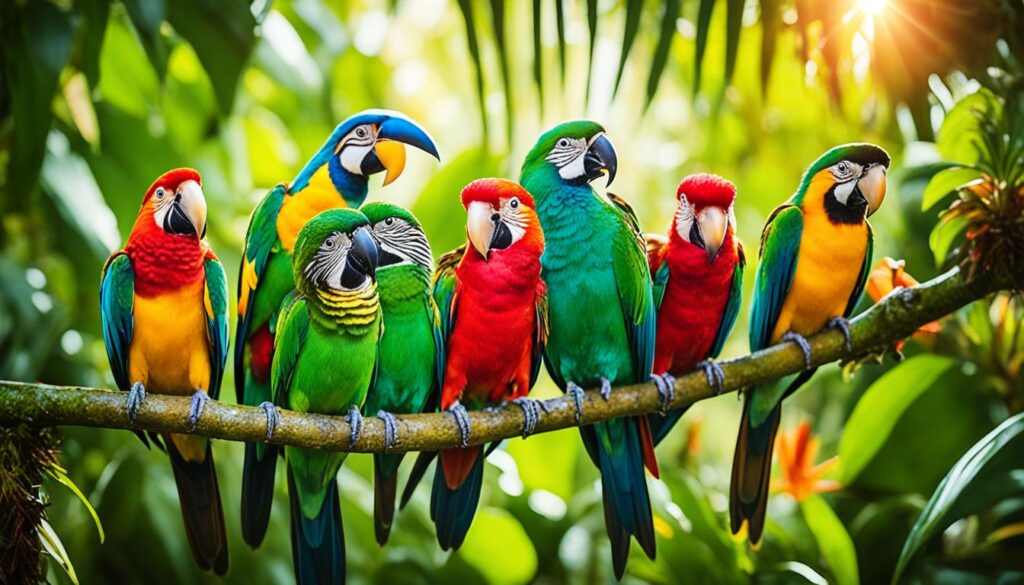
Bird Watching: Appreciating Nature’s Palette
For those captivated by the vibrant world of birds, bird watching offers an unparalleled opportunity to immerse oneself in nature’s breathtaking palette. This captivating pursuit allows enthusiasts to witness the stunning diversity of avian coloration firsthand, from the brilliant reds of cardinals to the striking blues of bluebirds.
Popular Bird Watching Hotspots
Around the globe, there are numerous destinations that have gained a reputation as premier bird watching havens. In the United States, regions like the Rio Grande Valley in Texas and the Everglades in Florida are renowned for their diverse populations of vividly colored bird species. Similarly, tropical bird watching hotspots like Costa Rica and Ecuador boast an abundance of avian nature jewels, drawing in bird watching enthusiasts from around the world.
Tips for Identifying and Observing Colored Birds
- Develop a keen eye for colored bird identification by studying field guides and bird apps to become familiar with common species.
- Time your bird watching excursions for the golden hours of dawn and dusk, when birds are most active and their colors are typically most vibrant.
- Invest in high-quality binoculars or a camera with a powerful zoom lens to capture the intricate details and vibrant hues of your feathered subjects.
- Become an active listener, learning to recognize the calls and songs of different bird species to aid in identification.
- Patience and stealth are key when observing colored birds; move slowly and quietly to avoid startling your avian targets.
By embracing these techniques, bird watchers can embark on a captivating journey of discovery, unlocking the secrets of nature’s most colorful creations.
“The joy of bird watching lies not only in the beauty of the birds themselves but in the opportunity to connect with the natural world around us.” – Unknown
Conservation Efforts for Colorful Bird Species
As the human impact on the environment continues to grow, many colorful bird species face increasing threats to their survival. Habitat loss, climate change, and other environmental stressors have put numerous avian populations at risk. This section will shed light on the various challenges faced by these vibrant feathered creatures and highlight the ongoing conservation efforts to protect them. Importantly, it will also provide readers with actionable ways in which they can contribute to the preservation of the colorful world of birds.
Threats and Challenges Faced
The survival of colorful bird species is threatened by a variety of factors, including:
- Deforestation and habitat destruction, which eliminate the natural homes of many vibrant bird populations
- Climate change, which can disrupt the delicate balance of ecosystems and force birds to adapt to new environments
- Illegal wildlife trade, which targets colorful bird species for their prized feathers and appearance
- Pollution and environmental contamination, which can compromise the health and reproduction of avian species
- Human-wildlife conflict, as birds are sometimes seen as pests or threats to agricultural interests
Ongoing Initiatives and How You Can Help
Fortunately, there are numerous conservation initiatives underway to protect colorful bird species and their habitats. These efforts involve:
- Habitat restoration and protection, such as the establishment of protected areas and the reforestation of degraded lands
- Breeding programs and captive conservation efforts to bolster the populations of endangered bird species
- Education and awareness campaigns to promote the importance of bird conservation among the general public
- Advocacy and policy changes to strengthen environmental regulations and enforce wildlife protection laws
- Citizen science initiatives that engage birdwatchers and nature enthusiasts in monitoring and reporting on bird populations
As individuals, we can contribute to the conservation of colorful bird species by supporting these initiatives, volunteering our time, and making conscious choices to reduce our environmental impact. Every small action can make a difference in preserving the vibrant diversity of our avian world.
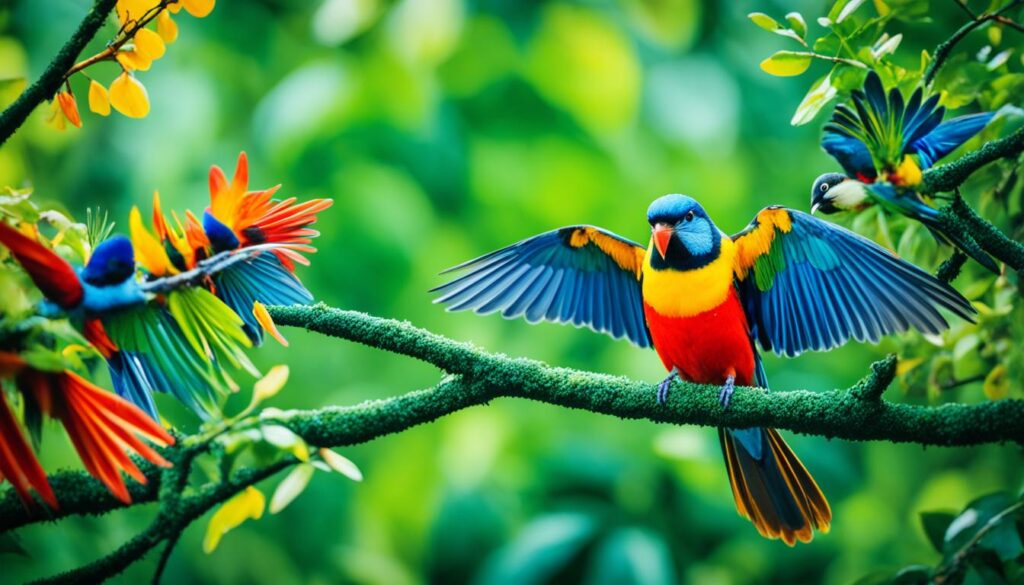
Conclusion: Embracing the Colorful World of Birds
The incredible diversity of colors found in the avian world is a testament to the beauty and wonder of nature. From the striking hues of tropical parrots to the serene shades of temperate songbirds, birds are truly remarkable creatures that captivate the human imagination. As we conclude our exploration of the colorful world of birds, it is essential to recognize the importance of embracing and preserving this vibrant avian realm.
Understanding the significance of avian coloration and its role in the natural world is a crucial step towards developing a deeper appreciation for these feathered marvels. Whether it’s the camouflage that helps birds survive or the dazzling displays that facilitate courtship and mating, the colors of birds play a vital part in their survival and behavior. By recognizing the intricate connections between bird coloration and the natural world, we can foster a greater respect and fascination for the avian realm.
Conservation efforts are paramount in ensuring the continued survival of the colorful bird species that enrich our planet. From supporting organizations dedicated to protecting threatened habitats to participating in citizen science initiatives that monitor bird populations, each of us can contribute to safeguarding the future of these feathered wonders. By embracing the colorful world of birds, we not only enhance our own understanding and enjoyment of nature but also play a vital role in preserving the vibrancy of the avian realm for generations to come.
FAQ
What are the primary sources of vibrant colors in bird feathers?
The vibrant colors of birds are primarily derived from the pigments present in their feathers, such as carotenoids and melanins. The distribution and concentration of these pigments within the feather structure determine the specific color patterns observed in different bird species.
How do bird color patterns contribute to their survival and reproduction?
Cryptic coloration helps many bird species blend seamlessly into their surrounding environment, providing protection from predators and aiding in their hunting and foraging strategies. Conversely, bold and vibrant plumage is often used in elaborate mating displays, where males showcase their colors to attract potential mates.
What are some of the most commonly encountered colored bird species?
Some of the most commonly encountered colored bird species include the vibrant reds of cardinals and tanagers, the brilliant blues of bluebirds and jays, and the dazzling plumage of tropical parrots.
How does a bird’s diet influence the development of its feather colors?
Certain pigments, such as carotenoids, are obtained from the food sources that birds consume, and these pigments are then deposited in their feathers, contributing to their overall coloration. The birds’ diet plays a significant role in the development of their vibrant plumage.
What are some of the popular bird watching hotspots around the world?
Some of the popular bird watching hotspots around the world include tropical rainforests, coastal regions, and high-altitude areas, where birdwatchers can witness the stunning diversity of avian coloration firsthand.
What are some of the threats facing colorful bird species, and how can I help with conservation efforts?
Colorful bird species face various threats, such as habitat loss, climate change, and environmental stressors. Ongoing conservation efforts aim to protect these vibrant feathered creatures, and individuals can contribute by supporting conservation organizations, participating in citizen science projects, and advocating for sustainable environmental practices.
